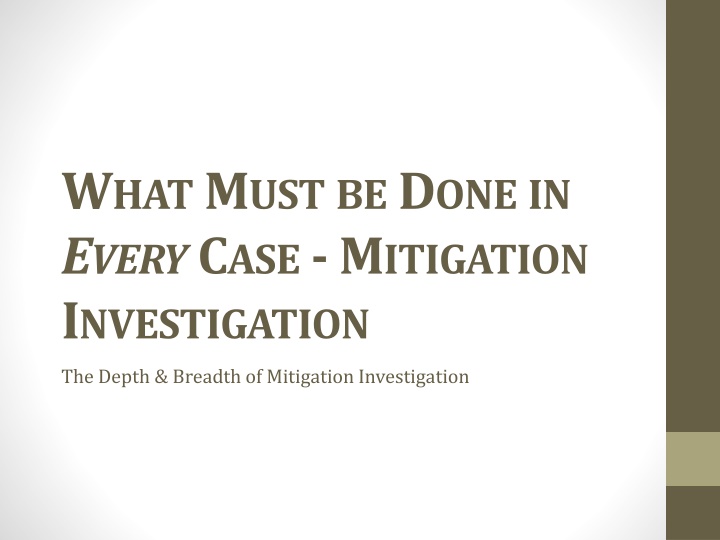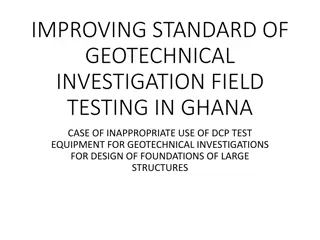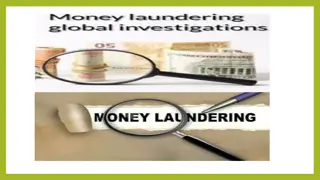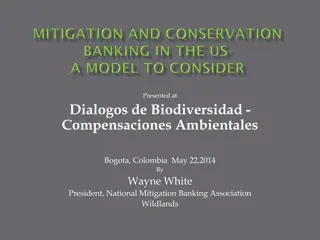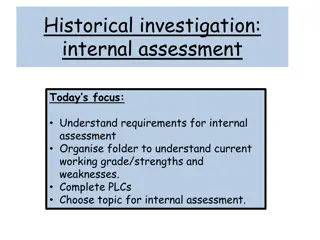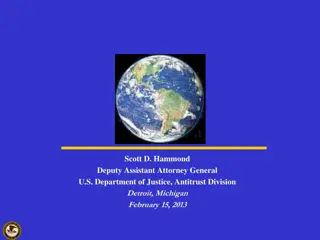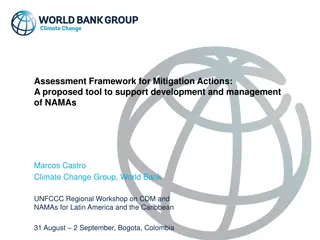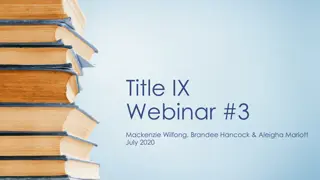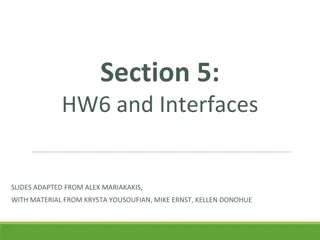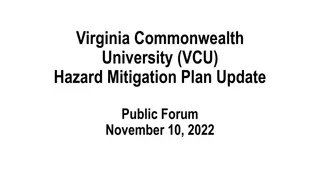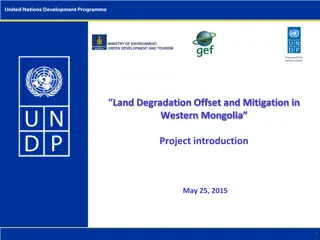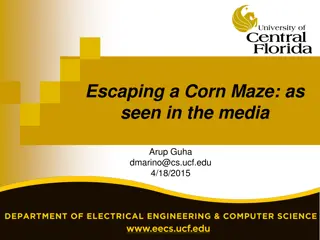Mitigation Investigation: Essential Practices for Comprehensive Depth & Breadth
Explore the crucial steps involved in a mitigation investigation, covering aspects such as scorched earth record collection, witness identification, private and public records to collect, and creating demonstrative evidence for a thorough examination. The guide emphasizes the importance of immediate action, meticulous record-keeping, and expanding the investigation to various sources for a comprehensive understanding.
Download Presentation

Please find below an Image/Link to download the presentation.
The content on the website is provided AS IS for your information and personal use only. It may not be sold, licensed, or shared on other websites without obtaining consent from the author.If you encounter any issues during the download, it is possible that the publisher has removed the file from their server.
You are allowed to download the files provided on this website for personal or commercial use, subject to the condition that they are used lawfully. All files are the property of their respective owners.
The content on the website is provided AS IS for your information and personal use only. It may not be sold, licensed, or shared on other websites without obtaining consent from the author.
E N D
Presentation Transcript
WHATMUST BEDONE IN EVERYCASE-MITIGATION INVESTIGATION The Depth & Breadth of Mitigation Investigation
Were going to cover: Scorched Earth Record Collection Scorched Earth Witness Identification
SCORCHEDEARTH RECORDCOLLECTION
The Basics: Start immediately. Releases from client and all family immediately multiple copies (some hospitals require original signatures, otherwise use photocopies where you can). Collect private records with releases, not subpoenas. Clients family 3 generations. Courthouse searches on every name that appears in the file. Do the digging yourself Accurint is good for locating a witness, not for courthouse searches. No Record? Get it in writing.
Private Records to Collect: (not an exhaustive list) Medical all hospitals from birth to present, free clinics whether client reports having gone Educational headstart, alternative schools, GED Mental Health same searches as medical Rehabilitation Drug Treatment Jail/Prison current case, ALL previous cases, ALL previous arrests Probation adult or juvenile, community service, parole, required classes (i.e. anger management, etc.) Military Financial Any bank information, property Social Security Welfare/social services including, CPS, Food stamps, homeless/domestic violence shelters, Medicaid, etc. Public Housing Employment - Job Corps, pay stubs, applications Church or youth groups Obits/Birth & Death Certificates Dental records Civil court records (state & federal) (property, tax, family (marriage, child custody, divorce, child support), civil suits (car accidents, civil rights suits, etc.), wills & probate, bankruptcy). Criminal court records (state & federal) (felony, misdemeanor, traffic, municipal, Justice of the Peace).
Public Records to Collect: (at minimum) Every prior arrest of client, family member or potential witness: Law enforcement files, D.A.s and their investigators, police, Sheriff, DPS, forensic crime labs (including private contractors), State Troopers, Rangers, DPS, Coroners/Medical Examiners Sheriff, Police, Fire dept., FBI, DEA, BIA, ATF, Homeland Security, etc. 911 calls for addresses where client grew up Personnel and/or civil service files of all state actors
Collecting and Creating Demonstrative Evidence: Artifacts of a life: Photos, ribbons, art, yearbooks, certificates, trophies, etc. Demonstrative Evidence Current photos of the client's ram shackled home, neighborhood, school, community, etc.; Videos; family trees.
SCORCHEDEARTH WITNESS IDENTIFICATION
Categories of people we need to interview: (not an exhaustive list) Family (extended) & friends Teachers Preachers, ministers, priests, clergy Neighbors Coaches Classmates Peers Other inmates Spouse, girlfriends Prison guards Social workers Parole officers Co-workers Work supervisors Doctors School nurse, cafeteria lady Child care providers
Your People List: You must start a People List early in the case. Expect to have hundreds of people on the list. That doesn t mean you are going to be able to interview all of them but we ll get to that later.
The obvious places: Client. Witness interviews.
The less obvious: Names pulled from records. Finding people ourselves.
Resources for finding people: TLO, Accurint, IRB, etc. We re used to using these to locate an address for someone when we have a name. However they can also be used to find old neighbors. You can search by address and the database will show you everyone it has recorded as living there and for what time periods. they can also be used to find relatives: TLO lists possible relatives.
Resources for finding people: Criss-Cross Directory The Criss-Cross Directory includes a comprehensive listing of residents and businesses in a market arranged by street and house numbers. If the neighborhood is local, drive around the area and figure out which street numbers were neighbors of the client and his family. If the neighborhood is not local, use google maps. If neither of these are an option, you can simple guess the street numbers that would have been in the vicinity of your client s home. Found in local libraries in Maricopa county there are Criss- Cross directories in the public library on Central. You can either make copies of all the relevant pages or take photographs with your phone.
Resources for finding people: School Year Books Where can you get them: Local public libraries School libraries Ancestry What they can help you with: If you have just teachers last names on school records then these can help you by providing a first name and a rough age to make locating the individual through TLO/Accurint/IRB possible. It may also provide you with the name of the school counselor or nurse who may be If a client cannot remember full names of classmates/friends take a copy of the year books with on on your next visit and he can point out them out to you. Arizona Dept. Education, Educator Certification Search: https://oacis.azed.gov/PublicOACIS/NormalPages/Educators.asp x
Resources for finding people: Ancestry Find family members that no other witness tells you about. Start building a family tree and Ancestry will prompt you of any individuals it thinks is related. Ancestry also has records available for download such as censuses, military cards, SS death index etc. These records in turn may name people you were unaware of.
Now you have a People List with 500 names on it So what now? Once you have a list of people you must decide as a team who to prioritize first. During a team meeting with all core members of the defense team present, run through the People List and determine who should be prioritized for interview.
Witness Interview Basics: Face-to-face, one-on-one interviews. No telephone interviews. Multiple interviews: interviewing is cyclical in nature and requires returning to the witness as new information is discovered.
